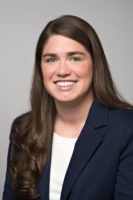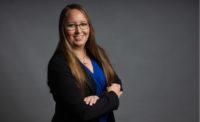Name: Gretchen Coleman
Age: 58
Title: P.E., CCP, CxA, EMP, owner, Gretchen Coleman Commissioning Group LLC
Educational Experience: Bachelor’s degree in architectural engineering, Kansas State University (KSU), 1985.
Professional Credentials/Accreditations: Coleman is a licensed professional engineer in Texas, Washington, Pennsylvania, Tennessee, Virginia, West Virginia, Maryland, North Carolina, South Carolina, Kentucky, and Florida. In 2002, she became the first woman Systems Commissioning Administrator (SCA) in HVAC and plumbing, courtesy of the National Environmental Balancing Bureau (NEBB). In 2004, she earned NEBB’s Fire Protection certification. Also in 2004, Coleman became the first woman Certified Commissioning Professional (CCP) by the Building Commissioning Association (BCA).
In 2009, she gained a Small Woman and Minority (SWaM) owned business certification from the Commonwealth of Virginia. In 2010, she gained her commissioning authority (CxA) by the AABC Commissioning Group (ACG). In 2012, she became an EMA Energy Management Professional (EMP). In 2014, Coleman earned a Historically Underutilized Business (HUB) designation by the state of North Carolina.
Organizational Affiliations/Achievements/Awards: Coleman became a founding member of the National Society of Architectural Engineers, which is now known as the Architectural Engineering Institute, in 1984; the Building Commissioning Association (BCA) in 1997; and the Building Commissioning Certification Board (BCCB) in 2004, which designed and certified the first CCPs for the BCA.
She served as the commissioning authority for the first K-12 Leadership in Energy and Environment Design (LEED) Gold-certified school in the U.S., Third Creek Elementary, in Statesville, North Carolina, which opened in 2002.
Coleman earned the BCA’s President’s Award in 2007 and served on the ACG’s CxA exam committee, which was responsible for revising the CxA certification exam in order to obtain ANSI accreditation and U.S. Department of Energy (DOE) approval for the CxA certification program. She also currently serves as the committee chair of the EMP exam committee, which was responsible for revising the EMP certification exam in order to obtain ANSI accreditation and DOE approval for the EMP certification program. In 2019, she earned BCA’s Benner Award and served as a judge at the Virginia State Science and Engineering Fair. Coleman maintains membership in the BCA, ACG, U.S. Green Building Council (USGBC), AEI, and her local ASHRAE group.
What caused you to/when did you fall in love with engineering?
I realized at about 8 years old that I could not be an astronaut because I wore glasses, so I turned my sights to architecture. I drew buildings ad nauseam as a child. By the time I reached high school, math had become my favorite subject. Unbeknownst to me, my high school chemistry teacher put my name in for an Outstanding Student in Math and Science scholarship to the school of engineering at KSU, which I received. Still being enamored of architecture, I was thrilled to find out there was a curriculum in architectural engineering, where I could both draw buildings and learn how to design the systems within. I loved it from day one.
What has been the most rewarding aspect of working in the skilled trades?
Figuring out why a building sucks or blows. The field of commissioning is so rewarding because one gets to solve problems whether during design or in the field during construction. It is rewarding to catch an issue during the design process and have a design engineer thank you for it. Just recently, I explained to a duct installer how a VAV box worked and why the duct he was installing at the time would cause turbulence, resulting in an inaccurate airflow reading. Duct installers are, in the construction hierarchy, one of the lower positions on the totem pole. Taking the time to explain the process and having the light bulb in his head come on was very rewarding.
Describe the proudest moment in your career.
Winning the Benner Award this year was one of the most rewarding moments of my career. Nancy Benner was one of the pioneers in the field of building systems commissioning. She started the National Conference on Building Commissioning (NCBC) in 1993, which just celebrated its 26th year. The award was established in 1999, shortly after Nancy passed away, to recognize outstanding achievements in making building commissioning “business as usual,” which was Nancy’s mission.
What challenges do women face in this profession? Can you give a personal example?
Women have come a long way since I started in the industry, but there is still room for improvement. Discrimination based on sex is still an issue, but in my experience, it has greatly improved. The last time I was openly disrespected, the fellow was fired on the spot. But in 1985, when I took my first professional engineering position, things were different. I was the only female engineer in the company I worked for in Dallas. I was also the only engineer who had not gone to the job site for a project several of us were working on, but all the guys had been. I was infuriated when the design engineer for a small tenant space in the building (at the time, it was Charlotte, North Carolina’s, tallest building) got to go to the project, when I was the designer for the base building and had not gone. I marched into the owner’s office and demanded to go and had to endure him stating that he was worried to send a female to a job site in case I was harassed (yes, this was a real threat). I told him, in no uncertain terms, that I had a mother and father who worried about me, and I did not need him to. I could take care of myself. I was on a flight to Charlotte within a week. Discrimination lawsuits were just beginning to have legs, and they did not want that to happen.
Another, more recent, example occurred as I described an issue I had encountered on a project during the design review process. The designer ignored the suggestion I had made that would fix the issue. Here comes the technical part — the chemical fume hood airflow, at the time, was controlled either by a sash position sensor or a through-the-wall pressure differential (DP) sensor. On the previous project, we had accidently discovered that the DP sensor was sensitive to temperature, and if the room was outside the range of 68°-72°F, it would report false readings. The monitor would be reading 100 feet per minute (design flow), but we would be independently measuring half of that, a dangerous situation for whoever is using the hood. On the next project, the owner had electricity brownout procedures that would intentionally raise the space temperature out of the acceptable range for the DP sensor if the electric company called. We suggested they use sash position sensors instead. The design was not changed and, guess what, all the sensors failed during functional testing. The manufacturer of the device did his own independent testing and concluded, yes, his sensor would fail in a brownout situation. He ended up having to rip out all his sensors and pay for sash position sensors to be installed. This was an incredibly costly endeavor in both dollars and time that could have been completely avoided. As to why there are not more women in engineering, I think women are not encouraged when they are young. So many girls grow up with idols in the entertainment industry, as that is what they are bombarded with constantly. How many years did it take to tell the story of the women, black women, at NASA who saved the space program? Girls these days barely know there are options in math and science. Luckily, there are schools that are starting to show those options. They bring in women on career days. I have served as a mentor for K-State students and have helped women in my own industry start their own companies or find better jobs. We have to expose young girls and women to options in the math and science industries and praise the teachers and parents who support them.
What does your day-to-day job entail?
If I’m in the office, I could be reviewing designs (mechanical, electrical, plumbing, fire protection), equipment submittals, or writing test procedures or final reports. If I’m in the field, I could be doing a site observation walk-through, attending commissioning or construction meetings, witnessing equipment startups or duct/pipe pressure testing, verifying test and balance reports, or performing functional testing on systems. Most MEP equipment these days is controlled by computers and have specific sequences of operations to meet. I test those programs and confirm they are meeting and delivering design parameters, such as temperature, humidity, airflows, and pressures.
What drives/motivates you every day?
The people I meet in this industry who want to do the absolute best job they can. There is nothing better than a project where the architect, engineers, construction team, and owner work as a unit with one purpose in mind — to deliver the best designed, built, and operating building they possibly can.
What remains on your engineering bucket list — what do you aspire to do that you haven’t accomplished yet?
I have this dream of starting a professional organization for women in commissioning. We would address issues such as outlined in question No. 4 as well as various other industry topics.
What’s one thing no one knows about you?
I’ve started writing a murder mystery novel about a female HVAC engineer.
List any mentors who’ve helped you succeed and describe exactly how they’ve shaped your success.
Rusty Hilst of Hutchinson High School in Hutchinson, Kansas, was my geometry and calculus teacher. That is where I fell in love with math.
Donna Bogner, Hutchinson High School, taught chemistry, and she was tough. After a couple of weeks, I was so sure I was failing the class that I told my mom I wanted to drop it. Mom made me go with her to talk to Mrs. Bogner, who looked at me and said, “That is your decision, but I would hate for the student with the highest grade in the class to drop out.” I couldn’t believe it. Between her and Rusty, I was well prepared to enter into the college of engineering at K-State. Nancy Benner, who, as mentioned above, started the NCBC, is also a mentor. Before each conference, she would call me and ask me to do a presentation. “Gretchen, you are the only one doing it, and people want to hear about your experiences.”
I always turned her down due to stage fright, but she still sought me out just to talk during the conferences. The year after she passed, I gave my first presentation on commissioning in her honor. She was my idol.
Ken Toombs was my boss on the first project we commissioned back in 1992. The owner of our company, Engineering Economics Inc., had sold the first third-party commissioned project in the U.S., and I was chosen to be on the team headed by Ken. I was hooked and made the decision right then that I was not going back to the boards (i.e., I was done with design). Ken and I worked together on commissioning projects until he started his own firm in 1995.
What advice do you have for prospective female engineers considering entering the field?
Just do it! If you are still in school, volunteer for a summer job with a contractor or engineering firm. Look for internships — they are out there. Get your feet wet in your field of choice. My first job in construction was for a homebuilder cleaning toilets and windows for $2 an hour. I didn’t like cleaning toilets, but I loved getting to look at floor plans and watch the work being done.
Participate in contests. As mentioned, I was recently a judge for the 2019 Virginia State Science and Engineering Fair. There were projects that were super simple and ingenious and projects that were incredibly complicated and frankly above my head, but the judging was as much about their presentation and ability to answer questions. It was a great opportunity for high school kids interested in engineering to do an experiment or invent something, present it, and get professional feedback.
Work any contacts you have. The niece of my cousin’s stepson’s wife called me to ask about my specialty in the field of engineering and where she could find an internship. I worked my contacts and helped her with internet searches, and within a month, she had an internship. People in the industry want to help.
Join professional organizations and be involved. Serve on committees and go to local activities. Sit with someone you don’t know at a lunch during a conference. I found one of my most steady clients that way. Persevere. There are wonderful companies that love having women engineers, and I suggest you keep looking until you find one.
Here is a little fun fact that has nothing to do with these questions. I looked at last year’s article and saw that Sheila Hayter had made the list. I used to work for her dad when I was a student at K-State. He ran the engineering extension service on campus, and I (and others) used to go out and do free energy surveys for anyone in Kansas who asked for it. I was happy to see she went into engineering.




